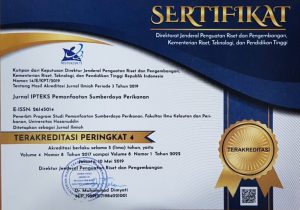Analysis of The Use of Rice Washing Water and Fermented Cassava Peel Waste on Population Growth of Daphnia Magna
DOI:
https://doi.org/10.20956/jipsp.v10i2.27214Keywords:
Daphnia Magna, Data Analysis, Fermented Cassava Peel Waste, Optimal Ecosystem, Rice Washing WaterAbstract
Daphnia magna is a potential natural food source due to its nutritional content. The availability of Daphnia magna is not always consistent, posing a challenge to fish cultivation. An alternative solution is to use rice wash water and fermented cassava peel waste as a source of nutrition for Daphnia magna. Rice wash water contains soluble nutrients, while fermented cassava peel waste is rich in nutrients from the fermentation process. This research was conducted in the Fisheries Cultivation Laboratory, 1st Floor, Universitas Muhammadiyah Gresik, in April-May 2023. The research method employed was experimental with five treatments and three replications. P1= 0% rice wash water, 100% fermented cassava peel; P2= 25% rice wash water, 75% fermented cassava peel; P3= 50% rice wash water, 50% fermented cassava peel; P4= 75% rice wash water, 25% fermented cassava peel; P5= 100% rice wash water, 0% fermented cassava peel. Data analysis used analysis of variance and least significant difference test. The results showed that treatment P3 had the highest population density with an average of 2578 individuals. Additionally, treatment P3 also yielded the highest growth rate of Daphnia magna, reaching a value of 28.35. The population distribution across all treatments predominantly showed the total length class <100µm. Overall, the water quality within the temperature range of 26-28°C and pH range of 6.5-8 indicated optimal conditions for the growth of Daphnia magna.
References
Agung, L. A., Herjayanto, M., Solahudin, E. A., & Ujianti, R. M. D. (2020). Growth Performance of Daphnia sp. Cultured in Different Concentration of Rice Washing Water. Advance Sustainable Science, Engineering and Technology, 2(2), 343563.
Chilmawati, D., Suminto. (2010). Pengaruh penggunaan ragi roti, vitamin b12 dan vitamin c sebagai bahan pengkaya pakan terhadap penambahan populasi Brancionus plicatis. Jurnal perikanan. 5 (2) : 47-53
FAO (1996), Food and Agriculture Organization of the United Nations; Rome, Italy: 1996. Report of the World Food Summit, 13-17 November 1996.
Gideon, P. C., Sucahyo, S., & Hastuti, S. P. (2022). Pengaruh Lama Aerasi yang Berbeda Terhadap Pertumbuhan Populasi dan Kualitas Warna dari Kutu Air Raksasa (Daphnia magna). Buletin Anatomi dan Fisiologi, 7(2), 66-74.
Herawati et al. (2013), ‘Perbaikan Parameter Lipid Darah Mencit Hiperkolesterolemia dengan Suplemen Pangan Bekatul’, Majalah Kedokteran Bandung, vol.45, no.1, pp. 1–9. doi: 10.15395/mkb.v45n1.93.
Islama, D., Nurhatijah, N., Muntadhar, M., & Fadhli, M. (2020). Pengaruh Pemberian Sumber Nutrien Berbeda Pada Media Kultur Terhadap Kepadatan Populasi Dan Laju Pertumbuhan Daphnia sp. Jurnal Akuakultura Universitas Teuku Umar, 2(2).
Izzah, N., & Herawati, V. E. (2014). Pengaruh Bahan Organik Kotoran Ayam, Bekatul, Dan Bungkil Kelapa Melalui Proses Fermentasi Bakteri Probiotik Terhadap Pola Pertumbuhan Dan Produksi Biomassa Daphnia sp. Journal of Aquaculture Management and Technology, 3(2), 44-52
Jubaedah, D. (2016). Pertumbuhan Populasi Daphnia sp. Dengan Pemberian Larutan Kulit Singkong Terfermentasi. Jurnal Akuakultur Rawa Indonesia, 4(1), 27-39.
Kusuma, B., Kusuma, R. O., Putra, J. J., & Fitriadi, R. (2020). Air Limbah Budidaya Lele dengan Total Dissolved Solid (TDS) berbeda untuk Media Budidaya Daphnia sp. Manfish Journal, 1(02), 101-106.
Kusumaryanto, H. (1988). Pengaruh Jumlah Inokulasi Awal terhadap Pertumbuhan Popualasi, Biomassa, dan Pembentukan Epipium Daphnia sp. Skripsi. Fakultas Perikanan dan Ilmu Kelautan. IPB. Bogor. 65 halaman.
Maulidiyanti, Santoso, L., & Hudaidah, S. (2015). Pengaruh pemberian pakan alami Daphnia sp yang diperkaya dengan tepung spirulina terhadap kelangsungan hidup dan pertumbuhan larva ikan komet (Carassius auratus). e-Jurnal Rekayasa dan Teknologi Budidaya Perairan, 4(1), 461-470.
Meilisa, R.D., Yulisman dan F.H Taqwa. (2015). Pertumbuhan Populasi Daphnia sp. Yang diberi Sari Dedak Terfermentasi Menggunakan Ragi Tape. Skripsi. Fakultas Pertanian. Jurnal Akuakultur Rawa Indonesia, 3(2) :48-54
Mubarak, A. S., L. Sulmartiwi, dan D.T.R. Tias. (2009). Pemberian Dolomit Pada Kultur Daphnia sp.p. Sistem Daily Fekeding Pada Populasi Daphnia sp. dan Kestabilan Kualitas Air. Jurnal Ilmiah Perikanan dan Kelautan, 1(1), 67-72.
Muhiddin, N. H., Juli, N., & Aryantha, I. N. P. (2001). Peningkatan kandungan protein kulit umbi ubi kayu melalui proses fermentasi. Jms, 6(1), 1-12.
Na, J., Kim, Y., Song, J., Shim, T., Cho, K., & Jung, J. (2021). Evaluation of the combined effect of elevated temperature and cadmium toxicity on Daphnia magna using a simplified DEBtox model. Environmental Pollution, 291, 118250.
Pires, A., Martinho, G., Chang, N.B., (2011). Solid waste management in European countries: a review of systems analysis techniques. J. Environ. Manag. 92, 1033–1050.https://doi.org/10.1016/j.jenvman.2010.11.024.
Peng, W., Liu, Y., Lin, M., Liu, Y., Zhu, C., Sun, L., & Gui, H. (2022). Toxicity of coal fly ash and coal gangue leachate to Daphnia magna: Focusing on typical heavy metals. Journal of Cleaner Production, 330, 129946.
Sarida M. (2007). Pengaruh konsentrasi ragi yang berbeda terhadap pertumbuhan populasi Daphnia sp, 269-272. Makalah dalam Seminar Hasil Penelitian dan Pengabdian Kepada Masyarakat. Universitas Lampung, Bandar Lampung.
Simanjuntak, H., Yuliana, E., & Sektiana, S. P. (2021). Kajian Budidaya Daphnia magna Menggunakan Air Rebusan Kedelai Dan Air Cucian Beras. PELAGICUS, 2(1), 45-52.
Subrero, E., Sforzini, S., Viarengo, A., & Cucco, M. (2019). Exposure to anti-mosquito insecticides utilized in rice fields affects survival of two non-target species, Ischnura elegans and Daphnia magna. Paddy and Water Environment, 17(1), 1-11.
Suprimantoro, S., Jubaedah, D., & Muslim, M. (2016). Pertumbuhan Populasi Daphnia sp. Dengan Pemberian Larutan Kulit Singkong Terfermentasi (Doctoral dissertation, Sriwijaya University).
Suryaningsih, (2006). Pengaruh Perbedaan Konsentrasi Rendaman Dedak Terhadap Populasi Daphnia sp. Skripsi. Faultas Kedokteran Hewan Universitas Airlangga.
TAPE, T. M. R. (2015). Pertumbuhan Populasi Daphnia sp. Yang Diberi Larutan Dedak. Jurnal Akuakultur Rawa Indonesia, 3(2), 48-54.
Tkaczyk, A., Bownik, A., Dudka, J., Kowal, K., & Ślaska, B. (2021). Daphnia magna model in the toxicity assessment of pharmaceuticals: A review. Science of the Total Environment, 763, 143038.
Utarini, D.R., Carmudi., & Kusbiyanto. (2012). Pertumbuhan Populasi Daphnia sp. Pada Media Kombinasi Kotoran Puyuh dan Ayam dengan Padat Tebar Awal Berbeda. Prosiding Seminar Nasional. Purwokerto: 27-28 November 2012.
Downloads
Published
How to Cite
Issue
Section
License
Copyright (c) 2023 Jurnal IPTEKS Pemanfaatan Sumberdaya Perikanan

This work is licensed under a Creative Commons Attribution 4.0 International License.














